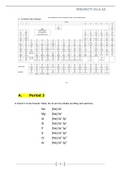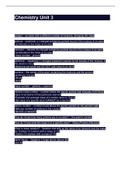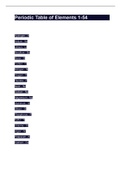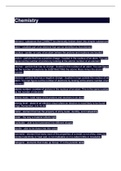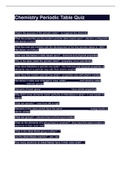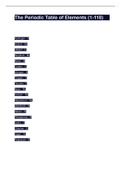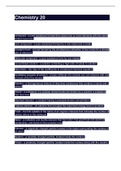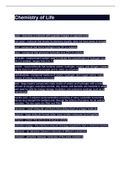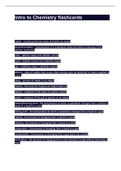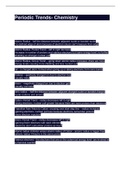A-level Chemistry
Latest uploads at A-level Chemistry. Looking for notes at A-level Chemistry? We have lots of notes, study guides and revision notes available for your school.
- 0
-
1
- 0
Courses at A-level Chemistry
Notes available for the following courses at A-level Chemistry
Latest notes & summaries A-level Chemistry
this document summarises the entire syllabus of periodicity and Gp 2 reactions for A level. clear, concise and success guaranteed! If you are struggling with remembering reactions of certain elements in periodicity of group 2, these notes are for you! Spare yourself the struggle of parrot learning and come learn inorganic chemistry in a smart way!
Chemistry Unit 3isotope -an atom with a different number of neutrons, changing the mass protons -positively (+) charged subatomic particle found in the nucleus of an atom -contributes to the mass of an atom 00:12 01:22 neutrons -Neutral (0) charged subatomic particle found in the nucleus of an atom -contributes to the mass of an atom -mass number - protons electrons -negatively (-) charged subatomic particle found outside of the nucleus, in the electron cloud -electrons are small and DO NOT add ...
Periodic Table of Elements 1-54 Periodic Table of Elements 1-54Hydrogen H Helium He 00:58 01:22 Lithium Li Beryllium Be Boron B Carbon C Nitrogen N Oxygen O Fluorine F Neon Ne Sodium Na Magnesium Mg 00:03 01:22 Aluminum Al Silicon Si Phosphorus P Sulfur S Chlorine Cl Argon Ar Potassium K Calcium Ca Scandium Sc Titanium Ti Vanadium V Chromium Cr Manganese Mn Iron Fe Cobalt Co Nickel Ni Copper Cu Zinc Zn Gallium Ga Germanium Ge Arsenic As Selenium Se Bromine Br Krypton Kr Rubidium Rb Strontium Sr...
Chemistrysmallest part of an element that can be identified as that elementsubstance that CANNOT be chemically broken down into simpler substancescenter, or core, of an atom (where the protons and neutrons are located)particle that has a positive charge - located in the nucleus of an atom. You can figure out the number of protons by looking at the atomic number of an cle that has no charge - located in the nucleus of an atom. You can figure out the number of neutrons by SUBTRACTING the atomic Ma...
Chemistry Periodic Table QuizWhat's the purpose of the periodic table? to organize the elements What two properties are the modern periodic table based upon? electron configuration and atomic number 00:12 01:22 What two men are credited with the development of the first periodic tables in 1869? Mendeleev and Meyer What was Mendeleev's table based upon? chemical and physical properties Why is the table called the periodic table? properties occur periodically What does Medeleev's periodic law s...
riodic Table of Elements (1-118)Hydrogen H Helium He 00:45 01:22 Lithium Li Beryllium Be Boron B Carbon C Nitrogen N Oxygen O Fluorine F Neon Ne Sodium Na Magnesium Mg Aluminum Al Silicon Si Phosphorus P Sulfur S Chlorine Cl Argon Ar Potassium K Calcium Ca Scandium Sc Titanium Ti Vanadium V Chromium Cr Manganese Mn Iron Fe Cobalt Co Nickel Ni Copper Cu Zinc Zn Gallium Ga Germanium Ge Arsenic As Selenium Se Bromine Br Krypton Kr Rubidium Rb Strontium Sr Yttrium Y Zirconium Zr Niobium Nb Molybdenu...
Chemistry 20compound a pure substance formed from atoms two or more elements with the same limited resources. ionic compound a pure substance formed by a non-metal and a metal. Covalent bond a bond formed by the simultaneous attraction of two nuclei for a shared pair of electrons. Molecular compound a pure substance form by non-metals. concentrated solution a solution containing a high ratio of solute to solution. Mole Ratio the ratio of the coefficients in a balanced chemical equation. Qualitat...
Chemistry of Lifepolar describes a molecule with opposite charges on opposite ends non-polar molecule that shares its electrons equally; does not have areas of charge acid compound that forms hydrogen ions (H+) in solution base compound that produces hydroxide ions (OH-) in solution pH scale measurement system used to indicate the concentration of hydrogen ions (H+) in solution; ranges from 0 to 14 protein macromolecule that contains carbon, hydrogen, oxygen, and nitrogen; needed by the body for...
Intro to Chemistry flashcardsmatter anything that has mass and takes up space physical property characteristic of a substance observed without changing it into another substance 00:41 01:22 solid definite shape and definite volume liquid definite volume but indefinite shape gas indefinite shape, indefinite volume plasma state of matter that occurs when energy such as electricity or heat is applied to a gas. mass amount of matter in an object volume the amount of space an object takes up density ...
Atomic Radius half the distance between adjacent nuclei or bonded nuclei *no defined edge of atom because of electron cloud- can't measure from edge Atomic Radius- Period Trend -left to right decrease -increase in number of protons and valence electrons but same energy level; no further shielding so stronger nuclear pull Atomic Radius- Group Trend -going down atomic radius increases -there are more energy levels causing more shielding and less nuclear pull Ion a charged atom; formed when giving...

